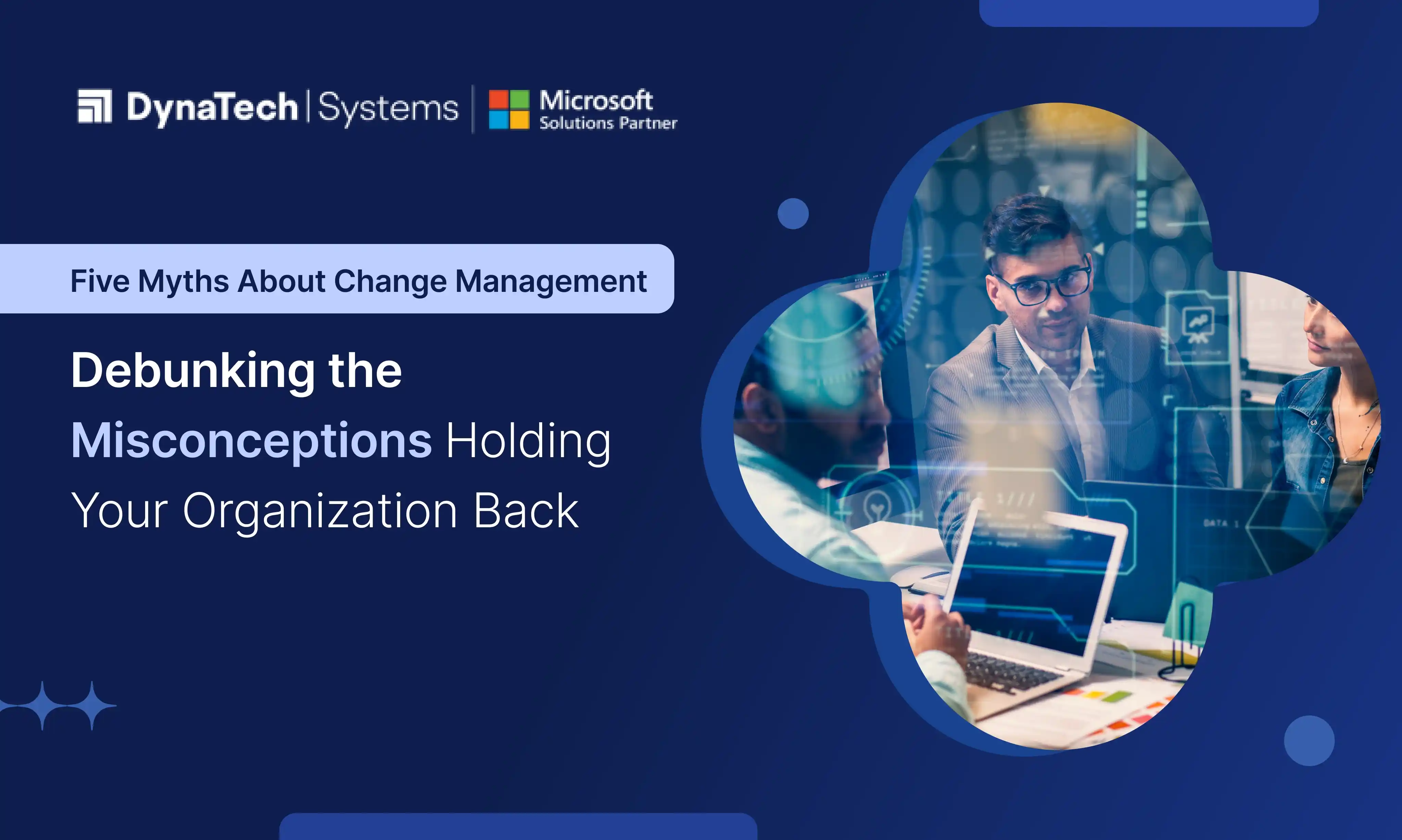Change is no longer optional—it's the heartbeat of growth and survival in today’s business world. Yet, even with its inevitability, many organizations find themselves unprepared or resistant when it’s time to evolve. What’s the real issue? It often comes down to lingering, outdated beliefs—those persistent change management myths that quietly hinder progress.
In this blog, we’re setting the record straight. We’ll uncover five common misconceptions about change management, draw clear lines between change management myths vs reality, and break down what effective change management really looks like. Along the way, we’ll walk through each stage of change management, helping you understand what it takes to lead meaningful transformation and answer the pressing question: what does change management look like in today’s ever-shifting business environment?
Myth 1: Change Management Is Just About Communication
The Misconception
One of the most common change management myths is that it's all about communication. Share an announcement, fire off a few emails, maybe schedule a town hall—and suddenly, everyone’s on board. Sounds easy, right? Unfortunately, this oversimplified view has derailed many transformation efforts.
The Reality
Yes, communication is crucial—but it’s only the tip of the iceberg. Effective change management is much deeper. It’s about guiding people through uncertainty, addressing resistance, and building momentum. True change touches people emotionally, cognitively, and behaviorally.
That’s where the ADKAR model by Prosci comes in. It breaks down successful change into five essential stages of change management:
- Awareness of the need for change
- Desire to participate and support the change
- Knowledge on how to change
- Ability to implement required skills and behaviors
- Reinforcement to sustain the change
So, while communication might open the door, it’s engagement, empathy, training, and ongoing support that lead to real, lasting transformation. That’s what change management looks like in organizations that get it right.
Myth 2: Change Management Is Only Needed for Large-Scale Changes
The Misconception
Many organizations fall into the trap of thinking change management is only necessary during major transformations—like mergers, acquisitions, or full-scale ERP implementations. The logic? “It’s just a small change; we don’t need a structured approach.” But that mindset often backfires.
The Reality
Here’s the truth: every change impacts people—no matter how minor it seems. Even small process tweaks, policy updates, or system upgrades can throw employees off balance, disrupt workflows, or spark resistance. Over time, these “little” disruptions add up.
Effective change management isn’t a one-size-fits-all model—it should be scaled based on the size and impact of the change. But that doesn’t mean skipping it altogether. Ignoring the human side of smaller initiatives often leads to a silent productivity killer: change fatigue—where teams feel worn down by an endless stream of unmanaged changes.
So, whether it’s a big bang transformation or a quick tweak, successful leaders understand what change management looks like at every level—and tailor their approach accordingly.
Myth 3: Change Management Is the Responsibility of HR
The Misconception
One of the more persistent change management myths is that it’s entirely HR’s job. After all, HR handles people-related matters, so shouldn’t they be the ones to manage change too?
The Reality
Yes, HR plays an important role—but effective change management goes far beyond one department. True transformation is a shared responsibility that cuts across the entire organization.
Here’s how it really works:
- Leaders set the tone, define the vision, and keep everyone aligned.
- Managers bridge the gap by turning strategy into action and supporting their teams through change.
- Employees aren’t just recipients of change—they’re active participants who provide feedback, embrace new ways of working, and help build a new normal.
When change management is treated as “just an HR initiative,” it loses momentum. There’s no accountability, no reinforcement, and often, no real adoption. But when everyone plays their part, change becomes part of the culture—and that’s what change management looks like in high-performing organizations.
Myth 4: Change Can Be Forced from the Top Down
The Misconception
Some leaders still believe that change management is as simple as issuing orders from the top. Set new goals, announce new rules, assign deadlines—and expect everyone to follow suit without question.
The Reality
While top-down directives can kickstart a change initiative, they’re rarely enough to make it stick. Effective change management isn’t about authority—it’s about alignment, trust, and shared ownership.
For change to take root, buy-in and collaboration are important at every level. Middle managers and employees, in particular have an important role to play. When they’re engaged in the process—not just informed about it—they’re far more likely to take ownership and responsibility, support others, and lead by example.
And let’s not forget: what change management looks like in thriving organizations includes leadership by example. People need to see the change in action. As the saying goes, "Be the change you wish to see in the world." That starts at the top—but grows from the ground up.
Myth 5: Change Management Ends Once the Change Is Implemented
The Misconception
A common trap many organizations fall into: thinking that once the new system is live or the process is launched, the job is done. “Implementation complete—on to the next!”
The Reality
In truth, implementation is just the starting line, not the finish. Effective change management extends well beyond go-live. If you don’t reinforce the change, it starts to unravel—people slip back into familiar habits, systems go underused, and the intended outcomes fall flat.
To make change truly stick, you need ongoing reinforcement. That includes:
- Continuous training to build confidence
- Feedback loops to course-correct
- Recognition to celebrate early adopters
- And ongoing adjustments to adapt the change to real-world dynamics
This is what change management looks like when done right—it doesn’t stop at implementation; it evolves with your people and your business. Skipping this phase? That’s how great initiatives turn into wasted efforts.
The Stages of Change Management: Navigating the Real-World Journey
Change doesn’t happen overnight—and it definitely doesn’t follow a straight line. That’s why understanding each stage of change management is critical when guiding your people through transitions that impact not just workflows, but mindsets.
Here’s how the journey typically unfolds in practice:
- Preparation: This is where groundwork is everything. It’s about gauging how ready your teams really are, clarifying what’s changing and why, and building a strategy that doesn’t just sit in a slide deck—it moves people. Skipping this step? That’s a fast track to misalignment later.
- Implementation: Now comes the doing. But real change management isn’t just project execution—it’s emotional navigation. You’re not just launching a new tool or process; you’re communicating clearly, adjusting on the fly, and supporting people through the bumps and resistance that naturally arise.
- Sustainment: Here’s where most organizations drop the ball. The change went live—great. But did it stick? That’s what this phase is about. Reinforce new behaviors, listen closely to what’s working (and what’s not), and keep refining. Otherwise, you’ll see a quiet return to the old ways of doing things.
Each stage demands its own approach, tools, and leadership mindset. Miss the mark in one area, and the ripple effect can stall progress across the board.
Busting the Change Management Myths and Best Practices to Follow
In today’s fast-moving business world, change is more of a constant undercurrent than a scheduled event. So what does change management look like now?
It’s not about ticking boxes or pushing out updates. It’s about people. It’s about momentum. It’s about adapting as fast as the environment around you does. Here's what that really means:
- Proactive Planning: Anticipate disruption before it lands. The most successful organizations aren’t just reactive—they bake agility into their culture.
- Stakeholder Engagement: If you’re not involving those impacted by change from the start, you’re already creating friction. Decision-making should feel collaborative, not top-down.
- Clear Communication: This isn’t about polished announcements. It’s about transparency. Timely updates. Space for questions. Consistent messages from leaders at every level.
- Training and Support: You can’t expect people to embrace change if they don’t feel equipped. Give them tools, training, and ongoing help as they adapt.
- Feedback Mechanisms: Change isn’t static. Build real-time feedback loops so you can course-correct and continuously improve. Because sometimes, even the best-laid plans need tweaks.
Final Thoughts: Change Isn’t a Task—It’s a Commitment
Change doesn’t stick because you told people about it. It sticks because someone took the time to guide, listen, and support when it mattered. That someone isn’t just HR or leadership—it’s everyone.
The biggest misconception? Thinking the hard part is launching the change. It’s not. The real work starts after. That’s when doubts show up, habits push back, and the excitement wears off. That’s when change either becomes part of how you work—or fades into another “initiative” people forget.
If your team’s tired, resistant, or just going through the motions, it’s not a sign of failure. It’s a sign to re-engage.
At DynaTech Systems, being Microsoft D365 Partner we don’t believe in check-the-box change management. We roll up our sleeves, understand your people, and walk with you from first conversation to lasting adoption—whether it’s rolling out Dynamics 365, optimizing operations, or supporting internal transitions.
If that’s what you’re looking for, we’re here. Let’s connect!




























